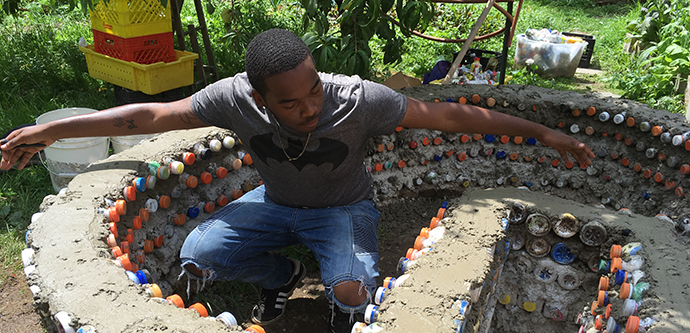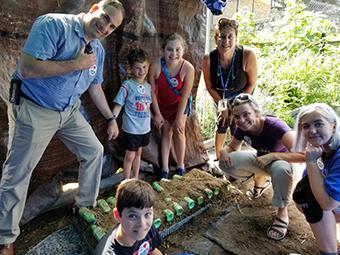
Bottle Brick Building: Lessons Learned

by Betsy Teutsch, for the Shuttle
And there it was: After two-plus years of neighborhood environistas compacting miscellaneous plastic into 20-oz. soft-drink bottles, a keyhole garden arose in the garden atrium at Sayre High School at 58th and Walnut streets. Eric Sherman, a nutrition educator for the Agatston Urban Nutrition Initiative working at Sayre, made it happen!
Sherman had been planning the project since he agreed to take our stash of 600 bottle bricks. Over the summer, he and his college interns worked with a group of high school students on the keyhole garden, now waist-high, a U-shaped structure that will eventually be filled with all manner of ingredients to become rich soil. (When planted, a keyhole garden can be easily maintained from the “keyhole” space in the center.)
The students described their construction experience at a celebration of summer projects connected to the University of Pennsylvania’s Netter Center for Community Partnerships. “Keyholes require a lot of cement. They save the environment. They are creative, very messy, beautifying, and decrease pollution.” Eric and his crew built with cement; the students really enjoyed learning and participating in the construction itself.
Meanwhile, at Ramah Day Camp in Elkins Park, nature educator Corri Gottesman collaborated with Wendy Smith and her family on a bottle brick garden bench. Wendy’s husband, Michael Posner, *really* likes an aloe drink that comes in square bottles. Wendy recruited other camp families to start bottle bricking for the Ramah garden, and by the start of camp they had several hundred bottle bricks at the ready.
Gottesman elected to build with cob, a natural cementing material. Campers loved mixing mud, sand, and straw, slapping it on the bottles, and gradually building a solid bench. Construction will continue into the fall.
The Weavers Way Environment Committee has been at the bottle brick project for several years now. Here are some lessons learned:
It’s a long way from an idea to a reality. I wrote about bottle bricks and keyhole gardens in my book on effective tools for poverty alleviation. It seemed to me that bottle bricks would be great for building a keyhole garden. However, I don’t live in the developing world, so my theory would have to be proven in our community. Fortunately, the Weavers Way Environmental Committee folks could see the potential and many of them quickly adopted the personal habit of brick-making. But we needed a partner. . . .
Matching supply and demand is hard. People were making the bricks, but it took quite a while to find a “project manager.” Logistical and labor challenges kept our first two partners from being able to follow through. We are very grateful to Eric and Corri!
People’s ideas about following instructions vary widely. Bottles bricks of all shapes and sizes started appearing, not just the 20-oz. size we had requested. Bricks need to be UNIFORM. Moving forward, we will heartily discourage weird sizes and shapes, unless someone can commit to making a lot of them. (Hello, Michael and Wendy!)
Keeping track of inventory is hard. We stored bricks in boxes, bins and crates at several different venues. Bad idea! It was really difficult to discern how many we had. In the future, we’ll be using a standard size box with handholds. They will be easy to stack and the brick count for each box will be the same. Sure, it’s Warehouse 101; now we’ve learned our lesson.
People are committed – dare I say addicted?— to bottle brick making. It is a hands-on, satisfying solution to the problem of what to do with the multitude of little discards in our lives. Moving forward, we need to do more projects. Have one to pitch? We are eager to hear your idea!
Betsy Teutsch is a Weavers Way Working Member. Contact her at bpteutsch@gmail.com.

